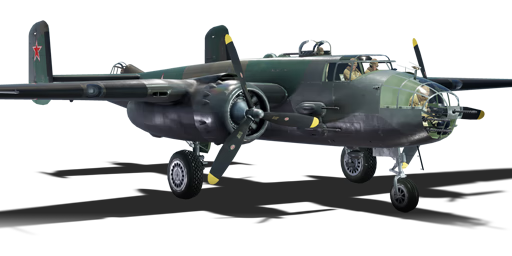



During the Second World War, as part of the lend-lease program with the US, the USSR received around 800 B-25 bombers, with the first aircraft arriving in April 1942 and mass deliveries beginning in 1943. The aircraft were quickly rushed into service and flew numerous sorties both during daytime and nighttime, as well as in poor weather conditions. The aircraft was primarily used as a long-range bomber but also saw use as a tactical bomber and even performed nighttime missions delivering supplies to partisans. The aircraft was praised for its speed and survivability, bomb load, radio equipment, as well as its advanced bombsight. During its service, various modifications were made, from additional fuel tanks to new bomb racks, which made the aircraft a lot more versatile and helped build its reputation in the Soviet Air Force. After the end of the war, instead of being returned to the US, the B-25s remained in service with the Soviet Air Force until 1953, being used as a trainer for Tu-4 crews due to it having the same style of landing gear as the Tu-4.
Introduced in Update 1.35, the B-25J-30 has access to a wide variety of Soviet bombs, ranging from the FAB-50 to the FAB-500, making it suitable for both base bombing and attacking ground targets. The B-25J-30 also comes with six 12.7mm Browning M2 heavy machine guns mounted at the front of the aircraft, which are excellent for strafing lightly armoured targets but also work great in head-on engagements with enemy aircraft due to their placement being on the sides and centre of the fuselage, providing a very concentrated field of fire. The defensive capabilities of this aircraft are also quite decent, being equipped with seven 12.7mm Browning M2s in various configurations, enough to shred enemy aircraft if they get too close.
flaps
flaps
flaps
brake
| Belt | Belt filling | Armor penetration (mm) at a distance: | |||||
|---|---|---|---|---|---|---|---|
| 10 m | 100 m | 500 m | 1000 m | 1500 m | 2000 m | ||
| T/Ball/Ball/I/AP-I | 28 | 26 | 18 | 11 | 7 | 4 | |
| AP-I/AP-I/AP-I/T/I | 28 | 26 | 18 | 11 | 7 | 4 | |
| T/AP/AP/AP/AP-I/I | 30 | 27 | 20 | 13 | 9 | 6 | |
| T/T/T/T/T/AP-I | 28 | 26 | 18 | 11 | 7 | 4 | |
| AP/AP-I/AP-I/I/I | 30 | 27 | 20 | 13 | 9 | 6 | |
| Belt | Belt filling | Armor penetration (mm) at a distance: | |||||
|---|---|---|---|---|---|---|---|
| 10 m | 100 m | 500 m | 1000 m | 1500 m | 2000 m | ||
| T/AP/I/AP-I | 30 | 27 | 20 | 13 | 9 | 6 | |
| AP/AP/AP/T | 30 | 27 | 20 | 13 | 9 | 6 | |
| AP-I/AP-I/AP-I/T | 28 | 26 | 18 | 11 | 7 | 4 | |
| Belt | Belt filling | Armor penetration (mm) at a distance: | |||||
|---|---|---|---|---|---|---|---|
| 10 m | 100 m | 500 m | 1000 m | 1500 m | 2000 m | ||
| T/AP/I/AP-I | 30 | 27 | 20 | 13 | 9 | 6 | |
| AP/AP/AP/T | 30 | 27 | 20 | 13 | 9 | 6 | |
| AP-I/AP-I/AP-I/T | 28 | 26 | 18 | 11 | 7 | 4 | |
8 × 50 kg FAB-50sv (forged) bomb
8 × 50 kg FAB-50sv (forged) bomb
9 × 50 kg FAB-50sv (forged) bomb
4 × 250 kg FAB-250sv bomb







 2 x (80 / 190 / 315) %
2 x (80 / 190 / 315) % 
 2 x 142 %
2 x 142 % 

Flight performance | |
|---|---|
Survivability |
|---|
Weaponry | |
|---|---|